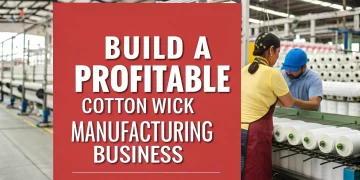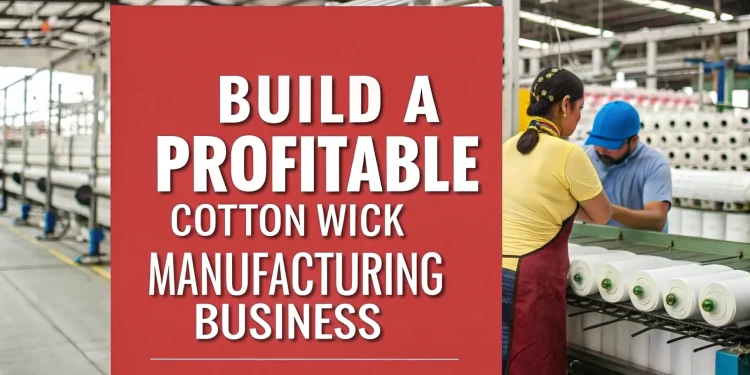Introduction
Starting a cotton wick manufacturing business is one of the easiest yet most rewarding small-scale industries in India. Wicks made of cotton have a strong link to culture, spirituality, and tradition. People in homes and temples alike rely on them for regular pujas, special offerings, and festive celebrations. Because of the ever-increasing need for these wicks in both cities and villages, the business demands only a small investment while offering a large profit and tremendous growth. For new entrepreneurs and startups, the combination of a little startup money, deep cultural meaning, and steady orders makes this an irresistible opening.
This guide goes step-by-step to show you how to build a successful cotton wick-making business. We’ll look at the needed raw materials, the production process, the market scope, the challenges to expect, and the kind of professional support available. Organizations like NIIR Project Consultancy Services (NPCS) help entrepreneurs establish these traditional yet in-demand businesses and show how to keep them profitable for the long haul.
Understanding the Market Potential
Cotton Wick Manufacturing has what experts call a ‘steady-state’ demand. People use them every day for pujas, aartis, and mandir offerings. Sales rise sharply during festivals like Diwali, Navratri, Durga Puja, Ganesh Chaturthi, and Pongal, yet the daily needs mean you can count on steady earnings the rest of the year.
In India, the market for religious products, including cotton wicks, is huge—worth billions of rupees. Cotton wicks are everywhere. City folks grab them off store shelves, while villagers buy both ready-made and hand-rolled kinds. Even cooler, sites like Amazon, Flipkart, and other spiritual-focused shopping sites let wick makers send their products all over India and to countries beyond, opening up new customers and markets.
This boom is great news for both tiny home businesses and mid-sized factories eyeing export. The raw materials are easy to find, and making the wicks isn’t rocket science, so anyone can start without fancy factories and big loans.

Related: Cotton Wick Manufacturing: From Fluff to Fire – Easy Guide
What You Need to Get Started
You’ll need three main things to set up a cotton wick workshop.
- Cotton: India grows loads of it. Pick high-quality long fibers—these can be twisted or rolled into the wicks. For a fancy touch, buy bleached or organic cotton for customers willing to pay a bit more.
- Tools: Simple shears, shaping knives, and hand-rollers are all you need for a basic operation.
- Machines: If you want to speed things up, look for semi-automatic or fully automatic wick machines. These can crank out wicks so quickly that you can fill bigger orders without losing the homey touch.
Packaging choices like pouches, boxes, and jars keep the wicks tidy and easy for shoppers to pick up.
Because cotton grows everywhere and is inexpensive, starting costs stay low. Entrepreneurs can keep healthy margins, even if they’re making just a few wicks a day. For a first-time maker, simple hand tools work fine, but anyone aiming for bigger sales will need a few semi-auto gadgets soon.
How Cotton Wicks are Made
You don’t need big machines to make cotton wicks. Here’s how the work gets done:
1. Cotton Prep – Raw cotton arrives from suppliers. It gets combed to take away seeds and dirt, which gives the wicks a steady, even flame.
2. Shaping – Workers roll the cleaned cotton into long cylinders for wicks. In South India, the rolls are thick for round wicks. Up North, the cotton is twisted and stretched into long, thin styles.
3. Cutting – The long cylinders are sliced into pieces, all the same length to fit shelves and shops.
4. Drying and Testing – The newly cut wicks are spread out to air-dry. Operators check each one for even thickness and how well it burns to make sure every pack is first-rate.
Packaging and Efficiency
Once produced, the finished cotton wicks are neatly packed in small, ready-to-sell pouches—typically holding between 50 and 100 pieces. Each pouch is sealed before it reaches the retail shelf, keeping the wicks clean and ready for use.
If you’re ramping up production, semi-automatic machines can crank out thousands of wicks every hour. Using this equipment cuts production time and keeps labor costs low. This scalability is great news, because a small neighbourhood shop can operate the same machines that a bigger factory uses.
Related: Start a Surgical Cotton Unit: Key Raw Materials You Must Source
Startup Costs and Earnings
Getting the ball rolling on a small cotton wick operation requires surprisingly little cash. You can start manually for just ₹25,000 to ₹50,000 enough for cotton, simple packaging, and a few hand tools. For a factory-sized setup with semi-automatic machines, you’ll need between ₹2 to 5 lakhs, depending on how many wicks you want to make each day.
What makes this business even sweeter is the profit margin. The cotton and other materials are cheap, so each pouch of 100 wicks costs only ₹5 to ₹8 to make. Those pouches can easily be sold for ₹15 to ₹25 in shops, and in bulk, the profit is even bigger. Offering packs to temples and wholesalers creates steady orders. Retail shops love them for the small, easy-to-display pouches with high profit for the shop.
Most sellers see their initial investment grow back in 3 to 6 months, making this one of the quickest small-scale businesses to pay off.
Marketing Opportunities and Distribution
Entrepreneurs venturing into cotton wicks can tap into several wide-ranging distribution pathways:
- Local kirana stores are still the anchor, with families buying wicks week after week. A reliable supply to these shops builds dependable daily sales.
- Wholesalers provide an efficient link by offering bulk wicks to temples, puja organizers, and shops that specialize in spiritual items. These partners create large, regular orders with minimal effort.
- Online marketplaces like Amazon and Flipkart, along with dedicated spiritual sites, let sellers showcase their wicks with professional packaging and storytelling. A few clicks can turn a homegrown brand into a national or even global concept.
- Festivals and fairs turn into flash sales opportunities. Setting up a kiosk at a melā or a local temple fair can triple daily sales during peak festive seasons.
- Smart packaging and labeling further widen a brand’s appeal. By selling wicks in attractive, hygienic packs, using organic cotton, and promoting eco-friendly production, sellers can command a premium in this otherwise traditional category.
Challenges in Cotton Wick Manufacturing
The cotton wick business is rewarding, yet a few hurdles still need to be managed. First, maintenance of a consistent quality of cotton is critical: one batch of inferior fibre can lead to wicks that burn unevenly, hurting the user experience. Second, the market’s low setup costs mean fresh competition springs up quickly. Instead of cutting prices, successful startups should double down on three priorities: investing in quality raw materials, offering eye-catching packaging, and using a dual distribution strategy that blends local sales and an online presence, keeping the brand front-of-mind no matter where a customer shops.
Another challenge is stepping up production. Hand-rolled wicks may work fine for a neighborhood shop, but anyone who wants to reach customers nationwide will need semi-automatic machines and modern packaging to keep queues moving and shelves stocked.
View our Handbooks for more information
Sustainability and Future Scope
As shoppers demand greener and chemical-free options, the case for organic cotton wicks grows stronger. Offering wicks woven from untreated cotton lets entrepreneurs command a higher price and attract eco-conscious buyers. Wicks can also be grouped with other spiritual items such as diyas, camphor, incense sticks, and essential oils to create ready-made gifting sets. Packaging these as bundles offers added convenience and a more attractive display on digital and physical shelves.
Looking ahead, the outlook for cotton wick producers is bright. Markets at home and abroad are expanding, helped by expanding e-commerce platforms and a rising preference for branded spiritual items. The ease of online shopping will keep new buyers discovering the calming ritual of a cotton wick, making this a sweet spot for sustained growth.
For more information, check out our related videos
How NPCS Can Help Entrepreneurs
Building a profitable cotton wick manufacturing business requires more than just understanding the basic process. It needs structured planning, market insights, and professional guidance. This is where NIIR Project Consultancy Services (NPCS) becomes invaluable.
NPCS provides comprehensive Market Survey cum Detailed Techno-Economic Feasibility Reports (DPRs) that cover:
- Detailed manufacturing process flows and best practices.
- Market research and demand analysis across regions.
- Capacity planning and product mix strategies.
- Machinery and raw material supplier details.
- Full financial projections, including cost analysis and profitability estimates.
By leveraging NPCS’s reports, entrepreneurs gain clarity on project feasibility, avoid risks, and position their businesses for long-term success. NPCS also helps in scaling up operations, identifying export potential, and planning for diversification into related spiritual product lines.
Find Your Perfect Business Match Using Our Smart Startup Selector
Conclusion
Cotton wick manufacturing stands out as one of the most practical, low-investment, and high-return opportunities for entrepreneurs in India. Its cultural and spiritual significance ensures uninterrupted demand, while the simplicity of the production process makes it easy for startups to enter. By focusing on quality, branding, and smart distribution, even small-scale producers can build a profitable venture in this sector.
With the professional guidance of NPCS, entrepreneurs can move beyond just starting a business—they can scale it sustainably, tap into new markets, and create a brand in the spiritual products industry. For startups looking to balance low risk with high profitability, cotton wick manufacturing is truly a golden opportunity.


















